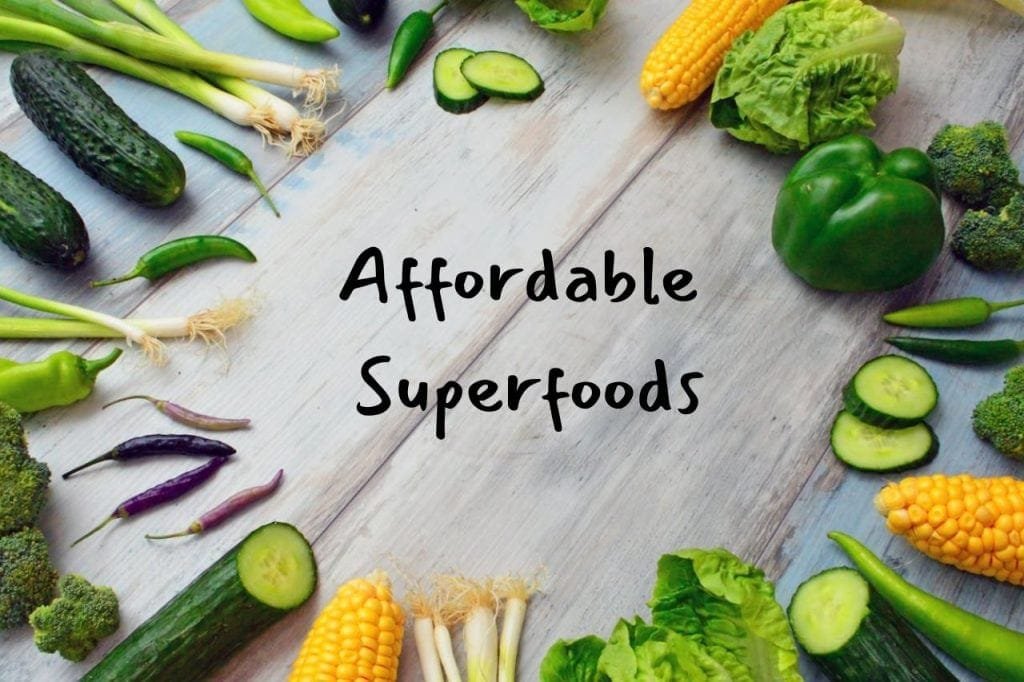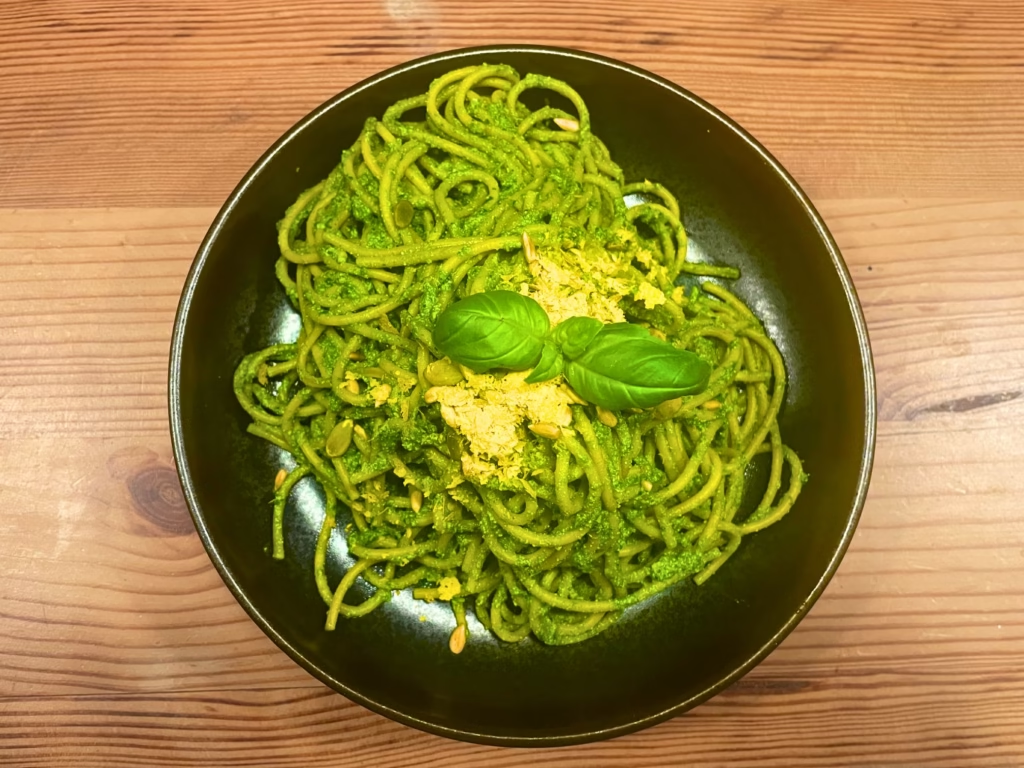When starting to eat healthy, the key is to stock up on nutritious food and always add a few superfoods to every meal. These affordable superfoods offer many health benefits without any side effects or breaking the bank.
I have divided these 20 affordable superfoods into categories: Nuts and Seeds, Vegetables, Grains, Fruit and Berries, Herbs and Spices and Drinks.
NUTS AND SEEDS
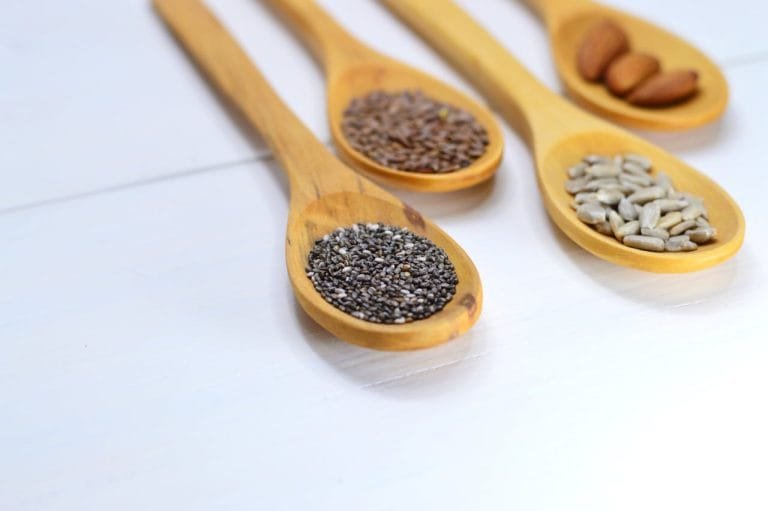
Seeds and nuts are affordable superfoods that can be sprinkled on salads and sandwiches, mixed in a smoothie, or added to any bakery. I learned A little tip from Tim Spencer: mix different kinds of nuts and seeds in a jar to make it easy to incorporate a variety of them daily.
Nuts and seeds are high in fat, so if you are trying to lose weight, use them in moderation.
Here are nuts and seeds that I always have in my cupboard:
1. Chia Seeds
Nutrition and Health Benefits:
Chia seeds are high in omega-3 fatty acids, particularly alpha-linolenic acid (ALA), which is beneficial for heart health.
They are also very high in fibre (34 grams per 100 grams ), good for digestive health, help lower cholesterol, and regulate blood sugar levels.
Their high protein (17g per 100 g) and mineral content support muscle function and bone health.
Chia seeds are also rich in antioxidants that help protect the body from free radicals, ageing, and cancer. (1)
Tips:
Soak this affordable superfood in water or plant milk, or add chia seeds to smoothies to make them more digestible.
2. Flaxseeds
Nutrition and Health Benefits:
Omega-3 Fatty Acids: Beneficial for heart health by reducing blood pressure, lowering cholesterol levels (2), and decreasing inflammation.
Fiber: Flaxseeds contain both soluble and insoluble fibres, which help maintain gut health, lower cholesterol, and regulate blood sugar levels.
Lignans: Flaxseeds contain the highest amount of lignans of any plant. Lignans have antioxidant properties and may help reduce cancer risk and improve reproductive health (3)(4).
Tips:
Grind or buy them ground to better access the nutrients.
Store ground flaxseed in the fridge or freezer in an airtight container to protect them from oxidation.
3. Almonds
Nutrition and Health Benefits:
Heart Health: Almonds’ high monounsaturated fat levels help reduce the risk of heart disease and lower LDL cholesterol.
Antioxidants: Vitamin E, an antioxidant, helps protect cells from oxidative damage, contributes to skin health as well as reduces the risk of chronic diseases.
Blood Sugar Control: The combination of healthy fats, fibre, and protein makes this affordable superfood excellent for regulating blood sugar levels (5).
Tips:
Buy almonds raw or dry-roasted without salt.
4. Walnuts
Nutrition and Health Benefits:
Walnuts are claimed to reduce the risk of cardiovascular disease, coronary heart disease, type II diabetes, and certain cancers, and lessen symptoms of age-related and neurological disorders. (6)
Walnuts are one of the healthiest nuts and are known for:
Heart Health: The omega-3 fatty acids in walnuts help to reduce the risk of heart disease by lowering bad cholesterol levels, reducing inflammation, and improving blood circulation.
Brain Health: ALA and other nutrients, like magnesium and copper, support brain function and can reduce the risk of neurodegenerative diseases.
Antioxidants: Walnuts are a good source of antioxidants, including vitamin E and manganese, that help protect against oxidative damage.
Anti-Inflammatory: The polyphenols in walnuts can help fight oxidative stress and inflammation, underlying many chronic diseases. (7)
Tips:
Store walnuts in the fridge or freezer to keep them fresh, as their high oil content can spoil at room temperature.
VEGETABLES

5. Kale
Nutrition and Health Benefits:
Kale is a versatile cruciferous vegetable. This affordable superfood is nutritious and can boost our overall health, whether added to salads, smoothies, soups, stews or stir-fries.
Antioxidant Properties: Kale is high in beta-carotene (a precursor to vitamin A), vitamin C, and various flavonoids and polyphenols, which help combat oxidative stress and reduce inflammation.
Heart Health: Kale’s fibre, potassium, vitamin C, and B6 content all support heart health. It also lowers cholesterol, especially when steamed.
Bone Health: High vitamin K content is essential for bone health because it improves calcium absorption.
Vision Health: The carotenoids, lutein, and zeaxanthin are good for eye health (8).
Tips:
Buy kale organic when possible and eat raw or lightly steamed to preserve nutrients. Lightly steaming kale increases the availability of its cholesterol-lowering bile acid sequestrants.
6. Beets
Nutrition and Health Benefits:
Blood Pressure Control: Beets’ high nitrate content which helps lower blood pressure and improve blood circulation(9).
Athletic Performance: beetroot juice improves muscle oxygenation during exercise(10).
Anti-inflammatory Properties: Beets contain pigments called betalains, which possess anti-inflammatory properties.
Detoxification: The betalains in beets also help detoxify the body by stimulating liver cells.
Tips:
Consume the beet roots and leaves, both cooked or raw. Drink beetroot juice before exercise to improve your performance.
7. Spinach
Nutrition and Health Benefits:
Spinach is particularly known for its high content of vitamin K, which is crucial for blood clotting and bone health. This affordable superfood is also rich in vitamin A, which is great for eye health, skin health, and immune function. The iron in spinach makes it a great food for combating anaemia.
Spinach is an affordable superfood that also contains several antioxidants, including lutein and zeaxanthin, which are important for eye health. The high levels of dietary fibre promote digestive health and help maintain low blood sugar levels. (11)
Raw spinach provides more folate, while cooked spinach offers more iron and calcium that’s easier to absorb.
Tips:
Spinach is rich in oxalates, which can bind to calcium and inhibit its absorption, potentially leading to kidney stones with high intake. Cooking spinach can reduce its oxalate content.
Combine spinach with a source of vitamin C (squeeze some lemon or eat spinach with bell peppers ) to boost iron absorption.
8. Sweet potatoes
Nutrition and Health Benefits:
Beta-carotene in orange sweet potatoes is essential for vision, skin health, and the immune system.
Antioxidants: The purple sweet potatoes contain anthocyanins that may prevent chronic diseases like heart disease and cancer.
Blood Sugar Regulation: Their high fibre content helps regulate blood sugar levels.
Anti-inflammatory Properties: The colourful pigments in sweet potatoes have anti-inflammatory benefits (12).
Tips:
Cook sweet potatoes with their skin to preserve nutrients.
9. Broccoli
Nutrition and Health Benefits:
Rich in Antioxidants: High levels of vitamin C and various flavonoids help reduce oxidative stress and lower the risk of chronic disease.
Cancer Prevention: Contains glucosinolates, which the body processes into compounds that have anti-cancer properties(13)
Supports Heart Health: broccoli’s fibre, potassium, and antioxidants may help prevent heart disease.
Bone Health: Provides good amounts of vitamin K and calcium, important for bone health.
Tips:
Steaming broccoli helps retain its colour, texture, and nutrition.
Eating broccoli raw in salads or as a snack maximises its vitamin C and sulforaphane content.
10. Saurkraut
Nutrition and Health Benefits:
Sauerkraut’s combination of low calories, high fibre, and probiotics make this affordable superfood an excellent addition to a healthy diet, providing both nutritional benefits and improving gut health.
Probiotics: As a fermented food, sauerkraut is rich in live probiotics that improve gut health and support the immune system.
High in Fiber: The dietary fibre in sauerkraut promotes healthy digestion.
Rich in Antioxidants: It contains antioxidants like vitamin C and carotenes, which can help reduce inflammation and lower the risk of chronic diseases(14).
Tips:
Choose unpasteurised sauerkraut found in the chilled section, as it contains live probiotics.
Heating sauerkraut can kill the beneficial probiotics, so et it cold or at room temperature.
11. Cabbage
Nutrition and Health Benefits:
Cabbage is an affordable superfood with a significant amount of phytonutrients.
High in Vitamin C: is a powerful antioxidant that helps protect the body against damage from free radicals.
Rich in Vitamin K: Essential for blood clotting and bone health.
Digestive Health: The high fibre helps improve digestion and maintain a healthy gut.
Anti-inflammatory Properties: It contains several anti-inflammatory nutrients, which can help reduce inflammation (15).
Tips: Red cabbage is the most nutritious type of cabbage due to its high levels of anthocyanins and antioxidants that give it its vibrant colour.
GRAINS

12. Quinoa
Nutrition and Health Benefits:
Complete Protein Source: Unlike many plant-based proteins, quinoa provides all nine essential amino acids.
High Fiber: The fibre content helps improve digestive health, aids in cholesterol management, and may help control blood sugar levels.
Rich in Antioxidants: Contains a variety of antioxidants that help combat oxidative stress and reduce the risk of chronic diseases.
Gluten-Free: quinoa is ideal food for people with gluten intolerance or celiac disease.
Tips:
Rinse before cooking to remove saponins that can cause a bitter taste.
13. Oats
Nutrition and Health Benefits:
High Fiber Content: It is particularly rich in beta-glucan, a type of soluble fibre that helps lower cholesterol levels, promote heart health, stabilize blood sugar levels, and help with weight management.
Rich in Antioxidants: Oats contain avenanthramides, antioxidants unique to this affordable superfood that help reduce blood pressure and provide anti-inflammatory effects (16).
Tips:
For the best benefits, choose the least processed forms of Oats, such as Whole Oat Groats, Steel-Cut Oats, or Rolled Oats.
If you want to find out more about oats, read: HOW TO CHOOSE THE BEST OATS FOR YOU
14. Lentils
Nutrition and Health Benefits:
Lentils are on the affordable superfood list because they are high in protein, iron, and fibre:
‘Lentils contain polyphenols, saponins, and phytosterols that help prevent chronic diseases, lower cholesterol, and have anti-inflammatory effects.’(17)
Tips:
Soak overnight to reduce cooking time and improve digestibility.
FRUIT AND BERRIES
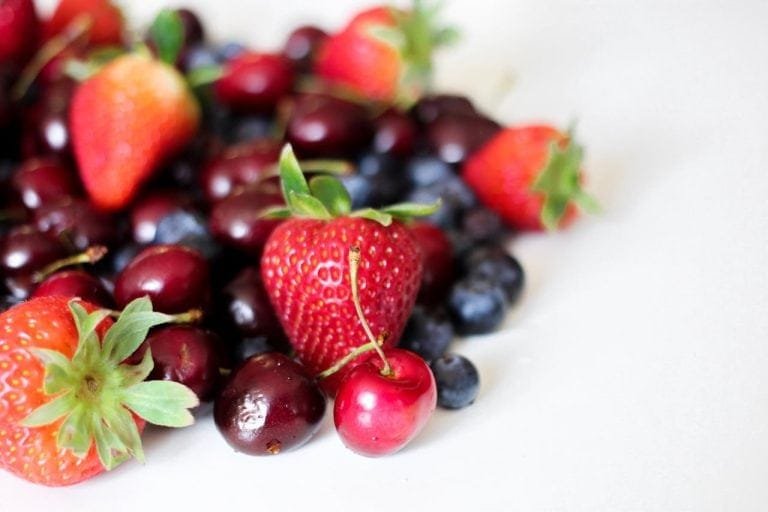
15. Blubberies
Nutrition and Health Benefits:
Blueberries have the highest antioxidant value of all fruits. The main antioxidant compounds are from the flavonoid group, including anthocyanins, which can reduce inflammation and may help reduce the risk of heart disease and cancer.
Blueberries can improve memory and cognitive function, potentially protecting against cognitive decline.
Heart Health: Blueberries’ fibre, potassium, folate, vitamin C, vitamin B6, and phytonutrient content support heart health.
Regulating Blood Sugar: blueberries have a low glycemic index and can positively impact blood sugar regulation, especially in type 2 diabetes patients. (18)
Tips:
Buy organic, or even better, forest blueberries to avoid pesticides. Eat them fresh or freeze them for smoothies. Frozen berries can retain nutrients better than fresh ones, as they freeze as soon as they are picked.
16. Avocado
Nutrition and Health Benefits:
Avocados offer numerous health benefits:
Avocados’ monounsaturated fats can help lower bad cholesterol levels, reducing the risk of heart disease.
The high fibre content helps improve digestive health and regulate appetite.
Nutrient Absorption: Avocados’ fats increase the absorption of fat-soluble vitamins like A, D, E, and K from other foods when eaten together.
Anti-Inflammatory Properties: Avocados contain anti-inflammatory compounds, which can help reduce the risk of inflammation-related conditions(19).
Tips:
Use ripe avocados to enhance the absorption of nutrients from other veggies. Avocados ripen best at room temperature; store them in the fridge once they are ripe to maintain freshness.
HERBS AND SPICES
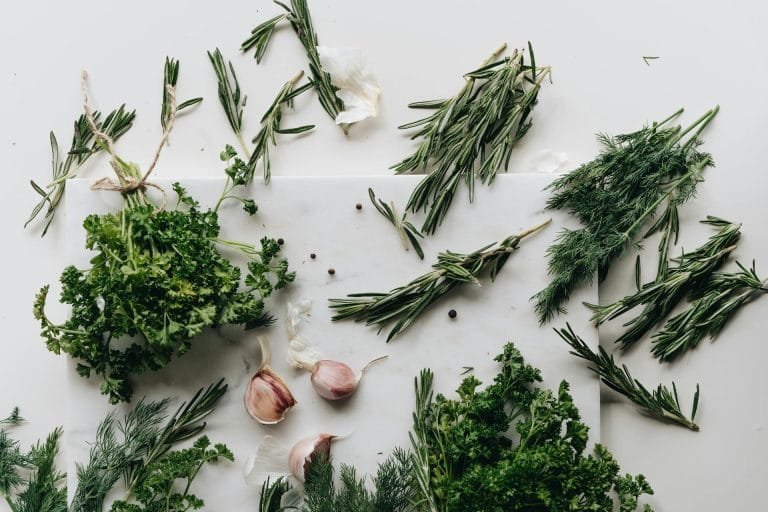
For more healthy herbs and spices suggestions, read THE TOP 10 HEALTHY SPICES AND HERBS FOR COOKING
17. Ginger
Nutrition and Health Benefits:
Ginger contains gingerol, a compound with powerful health benefits. Ginger is an affordable superfood noted for its potent anti-inflammatory and antioxidant effects.
Digestive Health: Ginger can help relieve nausea, including morning and motion sickness, and the effects of chemotherapy. It also aids in digestion and can reduce bloating.
Anti-Inflammatory and Antioxidant Effects: Ginger contains gingerol – a powerful anti-inflammatory and antioxidant compound. These properties can help manage arthritis, reduce soreness after exercise, and support overall immune function.
Pain Relief: Ginger can reduce period pain, headache and other pains.
Heart Health: Ginger may help lower blood pressure and cholesterol levels (20).
Tips:
For nausea, drink ginger tea or chew on raw ginger.
18. Garlic
Nutrition and Health Benefits:
Rich in vitamin C, vitamin B6, and manganese, garlic is known for:
Cardiovascular Health: Garlic lowers blood pressure and cholesterol levels, which can reduce the risk of heart disease.
Antimicrobial and Antiviral Properties: Garlic has natural antimicrobial and antiviral effects, which make it a powerful food for boosting the immune system.
Antioxidant Benefits: Garlic contains antioxidants that protect against cell damage and ageing. It may also reduce the risk of Alzheimer’s disease and dementia (21).
Tips:
Let chopped garlic sit for 10 minutes before cooking to enhance its health properties.
19. Tumeric
Nutrition and Health Benefits:
Anti-inflammatory Properties: Curcumin in turmeric can match the effectiveness of some anti-inflammatory drugs without the side effects.
Antioxidant Capacity: Curcumin neutralises free radicals and stimulates the body’s own antioxidant enzymes.
Brain Health: Curcumin boosts levels of the brain hormone BDNF, which increases the growth of new neurons and fights various degenerative processes in the brain.
Heart Disease: Tumeric improves the function of the endothelium and the lining of the blood vessels.
Cancer Prevention: Curcumin leads to several changes on the molecular level that may help prevent and perhaps even treat cancer (22)
Tips:
Combine with black pepper to enhance curcumin absorption by up to 2000%!
Curcumin is fat-soluble, so taking it with a source of healthy fat is a good idea.
Need more healthy spices and herbs inspiration, read here: The Top 10 Healthy spices and herbs for cooking
DRINKS

20. Green Tea
Nutrition and Health Benefits:
Green tea has high levels of bioactive compounds:
Polyphenols: These include catechins such as epigallocatechin gallate (EGCG), which is considered one of the most powerful compounds. Polyphenols are strong antioxidants that can reduce the formation of free radicals in the body, protecting cells from damage.
Theanine: An amino acid uniquely found in tea leaves, helping you relax.
Antioxidant Support: The catechins in green tea are powerful antioxidants that help prevent cell damage and provide anti-inflammatory effects.
Heart Health: Regular consumption of green tea is associated with reduced risk of cardiovascular diseases, including lower rates of stroke and improved cholesterol levels.
Weight Management and Metabolism: Green tea has been shown to enhance metabolic rate and increase fat burning in the short term.
Brain Health: Green tea’s combination of caffeine and L-theanine can have synergistic effects that improve brain function, including enhanced mood, focus, reaction time, and memory.
Cancer Prevention: Observational studies suggest that green tea drinkers are less likely to develop several types of cancer, though more high-quality research is needed to confirm these effects.
Tip:
Only buy organic green tea that is tested for heavy metals.
Steeping green tea for too long or at too high a temperature can make the tea bitter due to tannin release. It’s best steeped at 80-85°C (176-185°F) for about 2-3 minutes.
Drink 3-5 cups of green tea daily to maximize its health benefits.
I hope you found this List of 20 affordable superfoods and their science-proven benefits useful. I have enjoyed researching and learning new science-based nutrition knowledge. Most of these foods are incorporated into my diet daily, so I am happy to learn about all the great benefits.
What is your favourite affordable superfood?
Microgreens did not make it to this affordable superfoods list, but if you are interested, you can read this article: MICROGREENS – BENEFITS, NUTRITION & HOW TO GROW THEM
How to Eat Plant-Based On A Budget: 11 Beginner Tips
Is Organic Food Worth It? What You Should Buy Organic in 2025
Please Note: This post is for informational purposes only and is based on research. It’s not medical advice. It’s always best to consult a healthcare professional with health concerns. Enjoy reading!
- Shrestha, M., Shrestha, S., & Shrestha, N. (2022). Chemical Composition, Health Benefits and Applications of Chia seeds: A Review. Tribhuvan University Journal of Food Science and Technology. https://doi.org/10.3126/tujfst.v1i1.49934.
- Jenkins, D., Kendall, C., Vidgen, E., Agarwal, S., Rao, A., Rosenberg, R., Diamandis, E., Novokmet, R., Mehling, C., Perera, T., Griffin, L., & Cunnane, S. (1999). Health aspects of partially defatted flaxseed, including effects on serum lipids, oxidative measures, and ex vivo androgen and progestin activity: a controlled crossover trial.. The American journal of clinical nutrition, 69 3, 395-402 . https://doi.org/10.1093/AJCN/69.3.395.
- Westcott, N., & Muir, A. (2003). Flax seed lignan in disease prevention and health promotion. Phytochemistry Reviews, 2, 401-417. https://doi.org/10.1023/B:PHYT.0000046174.97809.b6.
- Rodríguez-García, C., Sánchez-Quesada, C., Toledo, E., Delgado-Rodríguez, M., & Gaforio, J. J. (2019). Naturally Lignan-Rich Foods: A Dietary Tool for Health Promotion?. Molecules (Basel, Switzerland), 24(5), 917. https://doi.org/10.3390/molecules24050917
- Barreca, D., Nabavi, S., Sureda, A., Rasekhian, M., Raciti, R., Silva, A., Annunziata, G., Arnone, A., Tenore, G., Süntar, I., & Mandalari, G. (2020). Almonds (Prunus Dulcis Mill. D. A. Webb): A Source of Nutrients and Health-Promoting Compounds. Nutrients, 12. https://doi.org/10.3390/nu12030672.
- Hayes, D., Angove, M., Tucci, J., & Dennis, C. (2016). Walnuts (Juglans regia) Chemical Composition and Research in Human Health. Critical Reviews in Food Science and Nutrition, 56, 1231 – 1241. https://doi.org/10.1080/10408398.2012.760516.
- Ros, E., Izquierdo-Pulido, M., & Sala-Vila, A. (2018). Beneficial effects of walnut consumption on human health: role of micronutrients. Current Opinion in Clinical Nutrition and Metabolic Care, 21, 498–504. https://doi.org/10.1097/MCO.0000000000000508.
- Ortega-Hernández, E., Antunes-Ricardo, M., & Jacobo-Velázquez, D. (2021). Improving the Health-Benefits of Kales (Brassica oleracea L. var. acephala DC) through the Application of Controlled Abiotic Stresses: A Review. Plants, 10. https://doi.org/10.3390/plants10122629.
- Mirmiran, P., Houshialsadat, Z., Gaeini, Z., Bahadoran, Z., & Azizi, F. (2020). Functional properties of beetroot (Beta vulgaris) in management of cardio-metabolic diseases. Nutrition & Metabolism, 17. https://doi.org/10.1186/s12986-019-0421-0.
- Domínguez, R., Maté-Muñoz, J., Cuenca, E., García-Fernández, P., Mata-Ordóñez, F., Lozano-Estevan, M., Veiga-Herreros, P., Silva, S., & Garnacho-Castaño, M. (2018). Effects of beetroot juice supplementation on intermittent high-intensity exercise efforts. Journal of the International Society of Sports Nutrition, 15. https://doi.org/10.1186/s12970-017-0204-9.
- Nemzer, B., Al-Taher, F., & Abshiru, N. (2021). Extraction and Natural Bioactive Molecules Characterization in Spinach, Kale and Purslane: A Comparative Study. Molecules, 26. https://doi.org/10.3390/molecules26092515.
- Alam, M. (2021). A comprehensive review of sweet potato (Ipomoea batatas [L.] Lam): Revisiting the associated health benefits. Trends in Food Science and Technology, 115, 512-529. https://doi.org/10.1016/J.TIFS.2021.07.001.
- Latté, K., Appel, K., & Lampen, A. (2011). Health benefits and possible risks of broccoli – an overview.. Food and chemical toxicology : an international journal published for the British Industrial Biological Research Association, 49 12, 3287-309 . https://doi.org/10.1016/j.fct.2011.08.019.
- Siddeeg, A., Afzaal, M., Saeed, F., Ali, R., Shah, Y., Shehzadi, U., Ateeq, H., Waris, N., Hussain, M., Raza, M., & Al-Farga, A. (2022). Recent updates and perspectives of fermented healthy super food sauerkraut: a review. International Journal of Food Properties, 25, 2320 – 2331. https://doi.org/10.1080/10942912.2022.2135531.
- Mabuchi, R., Tanaka, M., Nakanishi, C., Takatani, N., & Tanimoto, S. (2019). Analysis of Primary Metabolites in Cabbage (Brassica oleracea var. capitata) Varieties Correlated with Antioxidant Activity and Taste Attributes by Metabolic Profiling. Molecules, 24. https://doi.org/10.3390/molecules24234282.
- Kim, I., Hwang, C., Yang, W., & Kim, C. (2021). Multiple Antioxidative and Bioactive Molecules of Oats (Avena sativa L.) in Human Health. Antioxidants, 10. https://doi.org/10.3390/antiox10091454.
- Mustafa, A., Abouelenein, D., Acquaticci, L., Alessandroni, L., Angeloni, S., Borsetta, G., Caprioli, G., Nzekoue, F., Sagratini, G., & Vittori, S. (2022). Polyphenols, Saponins and Phytosterols in Lentils and Their Health Benefits: An Overview. Pharmaceuticals, 15. https://doi.org/10.3390/ph15101225.
- Kalt, W., Cassidy, A., Howard, L., Krikorian, R., Stull, A., Tremblay, F., & Zamora-Ros, R. (2019). Recent Research on the Health Benefits of Blueberries and Their Anthocyanins. Advances in Nutrition, 11, 224 – 236. https://doi.org/10.1093/advances/nmz065.
- Dreher, M., & Davenport, A. (2013). Hass Avocado Composition and Potential Health Effects. Critical Reviews in Food Science and Nutrition, 53, 738 – 750. https://doi.org/10.1080/10408398.2011.556759.
- Mao, Q., Xu, X., Cao, S., Gan, R., Corke, H., Beta, T., & Li, H. (2019). Bioactive Compounds and Bioactivities of Ginger (Zingiber officinale Roscoe). Foods, 8. https://doi.org/10.3390/foods8060185.
- Verma, T., Aggarwal, A., Dey, P., Chauhan, A., Rashid, S., Chen, K., & Sharma, R. (2023). Medicinal and therapeutic properties of garlic, garlic essential oil, and garlic-based snack food: An updated review. Frontiers in Nutrition, 10. https://doi.org/10.3389/fnut.2023.1120377.
- Kocaadam, B., & Sanli̇er, N. (2017). Curcumin, an active component of turmeric (Curcuma longa), and its effects on health. Critical Reviews in Food Science and Nutrition, 57, 2889 – 2895. https://doi.org/10.1080/10408398.2015.1077195.
Silvija Meilunaite, PN1-NC, CSMC, is a certified nutrition and menopause coaching specialist, and a writer in the nutrition and self-improvement field. She explores science-based approaches to holistic health and plant-based nutrition, with a strong focus on researching clean, non-toxic products that support long-term well-being.
- S. Meilunaitehttps://barefootbasil.com/author/silvootegmail-com/
- S. Meilunaitehttps://barefootbasil.com/author/silvootegmail-com/
- S. Meilunaitehttps://barefootbasil.com/author/silvootegmail-com/
- S. Meilunaitehttps://barefootbasil.com/author/silvootegmail-com/
